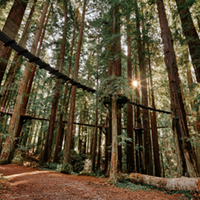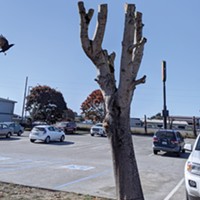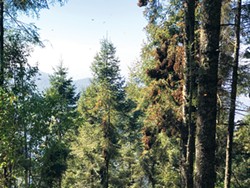[
{
"name": "Top Stories Video Pair",
"insertPoint": "7",
"component": "17087298",
"parentWrapperClass": "fdn-ads-inline-content-block",
"requiredCountToDisplay": "1"
}
]
I recently — and rashly — accepted an invitation to co-teach a class on trees, bowing to the old saw about learning by teaching. Fortunately, my co-teachers kept me honest and I was able to capitalize on my ignorance. Turned out some of my "facts" weren't. Like the following:
Wood from "hardwood" trees is always harder than wood from "softwood" trees
While generally true, the "hard" and "soft" designation is one of form: hard woods are deciduous and bear fruit or flowers (like maple and apple); soft woods are mostly conifers (like pines). The most obvious exception is balsa — a hardwood — which, as model-makers know, is about as soft as a wood can be.
Tree trunks act as a one-way highway from roots to leaves
Nope, it's a two-way road. In order for the roots to function (usually in symbiosis with fungi), they need energy in the form of sugar. That's created in the leaves, where carbon dioxide and water are nudged by chlorophyll to produce sugar and oxygen. Remember the magic of photosynthesis from high-school chem? 6CO2 + 6H20 → 6O2 + C6H12O6 (glucose). The sugar goes down the trunk on the inside bark (phloem) to the roots, where it combines with water and minerals. Sap then rises in the sapwood (xylem).
All of a tree is alive
Actually, most of a tree comprises dead (but structurally vital) wood cells, plus, of course, the bark "armor." The living, metabolizing tissue of a tree — leaves, buds, roots and the cellular layers immediately under the bark (see above) — typically makes up less than 1 percent of a tree's overall volume.
A tree is either deciduous or conifer
Deciduous trees are those that lose their leaves periodically, usually in the fall. While it's true that most conifers, i.e. cone-bearing trees, retain their needles, some are deciduous: larches or Larix, such as the tamarack, are the largest group of deciduous conifers. Also the dawn redwood (Metasequoia glyptostroboides). Don't believe me? Check out our local specimen outside Eureka City Hall.
When deciduous trees lose their leaves, it's always because winter is coming
That's true in temperate climes, but in the tropics, many deciduous trees lose their leaves to conserve water when the dry season is approaching.
Conifers can't grow in the tropics
Many conifers (mostly pines) thrive between the Tropics of Cancer and Capricorn. One beneficiary: the 100-million-plus monarch butterflies that overwinter at around 10,000 feet. in Mexico's pine forests.
Trees are dumb
Not according to "tree whisperer" Peter Wohlleben, whose book The Hidden Life of Trees: What They Feel, How They Communicate has become an unlikely bestseller here and in Europe. One of Wohlleben's examples concerns elms and pines that "sense" they're under attack by leaf-eating caterpillars by detecting caterpillar saliva. In response, the trees release wasp-attracting pheromones; the wasps lay their eggs inside the caterpillars, which are then eaten from the inside by wasp larvae.
And finally, in respect to the season: Christmas trees are a Christian tradition
Like mistletoe and holly, mincemeat pies and Yule logs, decorating fir trees at the Christmas season has pagan roots. Evergreens were long thought to have supernatural life-giving powers, particularly near the winter solstice (when other trees have lost their leaves), which is why many Christian sects oppose what they see as "tree worship."
Barry Evans ([email protected]) opposes cutting down Christmas trees on thoroughly secular grounds.
Speaking of Trees, Monarch Butterflies
-

Sequoia Park Zoo Skywalk in Final Stages
Feb 6, 2021 -

Winter Pruning on the North Coast
Feb 4, 2021 - More »
more from the author
-
The Other Evolutionist
- Jul 25, 2024
-
Rise and Fall of the "Sunshine Vitamin," Part Two
- Jul 11, 2024
-
Rise and Fall of the 'Sunshine Vitamin,' Part One
- Jul 4, 2024
- More »

































